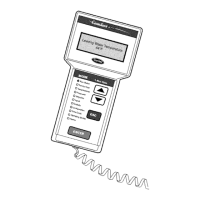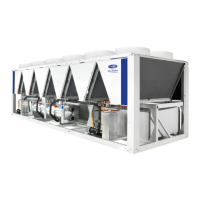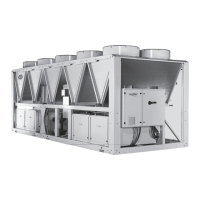32
M20 nut Chassis 190
M20 nut Heat exchanger side-side connection 240
M16 nut Compressorxing 190
H M16 screw Heatexchangerwaterboxes,structure 190
H M16 screw CompressorsuctionangesTT 190
H M20 screw CompressorsuctionangesTU&TV 240
M16 nut CompressordischargelineTT&TU 190
M20 nut CompressordischargelineTV 240
H M12 screw Economiserportange&economiserport
valve, option 92
80
H M8 screw Drier cover 35
1/8NPTconnection Oil line 12
TEnut Compressor oil line 24,5
7/8ORFSnut Oil line 130
5/8ORFSnut Oil line 65
3/8ORFSnut Oil line 26
H M6 screw Staucollar 10
TaptitescrewM6 Oil line collar 7
TaptitescrewM6 Brassbody,economiserline 10
Metric screw M6 Steelplatexing,controlbox,terminalbox 7
TaptitescrewM10 Oillter,economisermodule,controlboxxing 30
Check that:
• the insulating foam is intact and securely in place,
• the sensors and ow switch are correctly operating
and correctly positioned in their support,
• the water-side connections are clean and show no sign
of leakage.
13.7.1 - Oil lter change schedule
As system cleanliness is critical to reliable system operation,
there is a lter in the oil line at the oil separator outlet. The
oil lter is specied to provide a high level of ltration (5 µm)
required for long compressor life.
The lter should be checked after the rst 500 hours of
operation, and every subsequent 2000 hours. The lter should
be replaced at any time when the pressure differential
across the lter exceeds 2 bar.
The pressure drop across the lter can be determined by
measuring the pressure at the discharge port (at the oil
separator) and the oil pressure port (at the compressor).
The difference in these two pressures will be the pressure
drop across the lter, check valve, and solenoid valve. The
pressure drop across the check valve and solenoid valve is
approximately 0.4 bar, which should be subtracted from the
two oil pressure measurements to give the oil lter pressure
drop.
13.4.3 - Connection precautions for the power contactors
These precautions must be applied for units equipped with
06TUA554, 06TVW753 and 06TVW819 compressors. For
these units the power contactor type is 3RT1064 (Siemens).
The contactors allow two connection positions in the cage
clamps. But only one position allows safe and reliable
tightening on the contactor (KM1 or KM2). The conductor
must be positioned in front of the connection area when it
is tightened. If it is tightened behind the area, there is a risk
that the brackets will be damaged during the tightening.
Conductor position
conductor position
13.4.2 - Connection precautions for the compressor power
terminals
These precautions must be applied during an intervention
that requires the removal of the power conductors connected
to the compressor supply terminals.
The tightening nut of terminal (6) supporting the isolator
(7) must never be loosened, as ist ensures terminal tightness
and compressor leak tightness.
The tightening of phase lug (4) must apply the torque
between counter nut (5) and tightening nut (3): during this
operation a counter-torque must be applied at counter nut
(5). Counter-nut (5) must not be in contact with the tightening
nut of terminal (6).
1. Torqueapplicationtotightenthelug
2. Avoidcontactbetweenthetwonuts
3. Lugtighteningnut
4. Flatlug
5. Counter-nut
6. Terminaltighteningnut
7. Isolator

